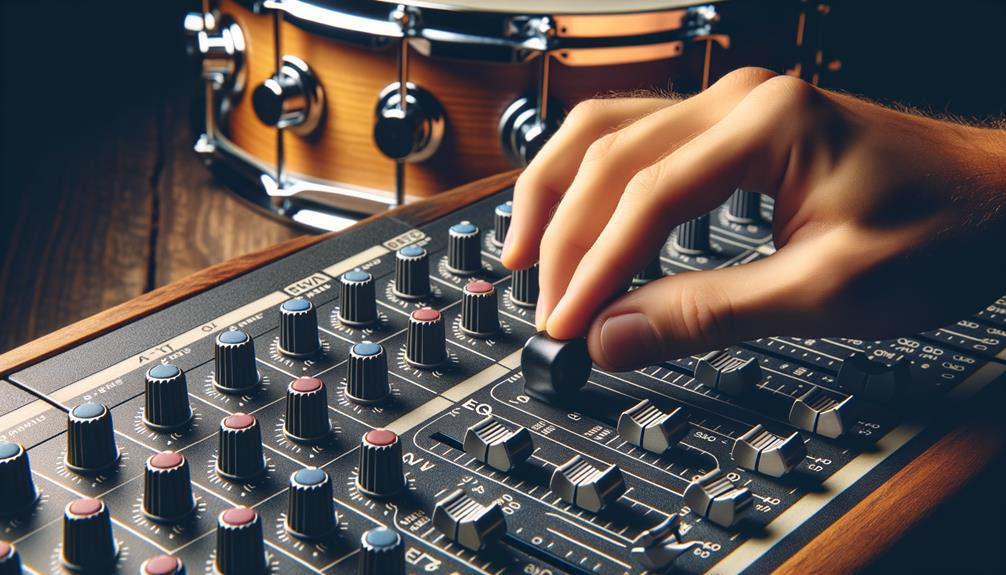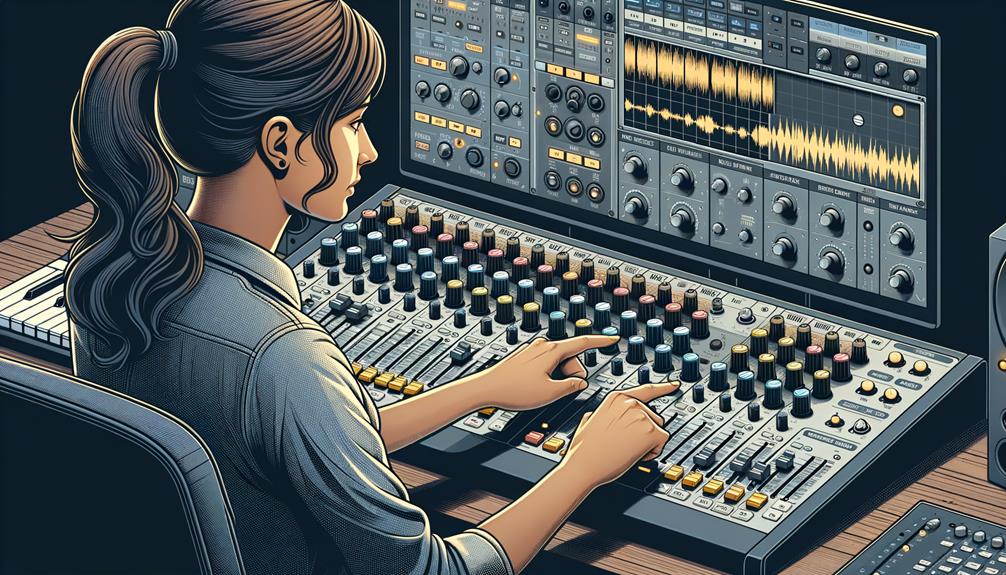No products in the cart.
So, you’ve spent countless hours perfecting the rhythm and groove of your track, and now it’s time to tackle the snare drum.
Did you know that the snare drum is often considered the backbone of a song, providing both the rhythmic pulse and the sonic character that defines the overall feel?
When it comes to EQing your snare, there are specific frequencies you can target to enhance its thump, bite, and snares, but that’s just the beginning. Mastering the art of EQing a snare can take your mix to a whole new level, elevating the impact and clarity of your drum sound.
But how do you go about achieving that perfect snare EQ? There are a few key techniques and considerations that can make all the difference.
Contents
hide
Key Takeaways
- Boost frequencies between 120-300Hz to enhance fullness and body of the snare drum
- Manipulate frequencies in the 2-10kHz range to tailor the timbre and crispness of the snare
- Use high-pass filtering to eliminate unnecessary low-end frequencies and reduce muddiness
- Incorporate snare samples to augment the overall sound and presence of the snare drum
Understanding Snare Drum Frequencies
Boost frequencies between 120-300Hz to enhance the fullness and body of the snare drum, contributing to a more powerful and robust sound. This range is critical for shaping the fundamental tonality of the snare, providing a solid foundation for the overall sound.
By increasing these frequencies, you can bring out the natural resonance and depth of the drum, adding weight and impact to your mix.
Additionally, boosting 500Hz-1kHz can impart a distinctive wooden character to the snare, further defining its unique sonic identity. Manipulating frequencies in the 2-10kHz range allows you to tailor the snare’s timbre, emphasizing its crispness and presence within the mix.
Utilize a high-pass filter to eliminate frequencies below 100Hz, effectively reducing unwanted noise and rumble that can muddy the sound. To further refine the snare’s sonic profile, consider employing a low shelving EQ to cut low mids if necessary, enhancing clarity and reducing any potential muddiness.
Understanding and skillfully handling these frequencies is pivotal in sculpting the ideal snare sound to elevate your music production to new heights.
Techniques for Cleaning Up the Snare
To refine the snare’s sonic profile and achieve a cleaner sound, utilize techniques such as high-pass filtering to remove unnecessary low-end frequencies and cutting the low mids using a low shelving EQ if needed to reduce muddiness in the snare sound.
When cleaning up snare sounds in drum recordings, employing a high-pass filter is essential to eliminate low-frequency rumble and stage wash, which can muddy the mix. By setting the high-pass filter around 80-120 Hz, you can effectively remove unwanted low-end frequencies without affecting the snare’s fundamental tone.
Additionally, using a low shelving EQ to cut the low mids around 250-500 Hz can further enhance the clarity of the snare sound, making it more defined and focused. This technique is particularly useful for addressing any muddiness in the snare drum’s midrange frequencies, ensuring that it sits well in the mix.
Enhancing Snare Drum Character

Enhancing the snare drum character involves carefully adjusting specific frequency bands to bring out the desired tonal qualities and ensure it cuts through the mix with clarity and definition.
To enhance the snare drum character, you can EQ the snare by targeting specific frequency ranges. Boosting the low end around 200Hz-300Hz can add more thump and body to the sound, giving it a solid foundation. Boosting the high end, particularly around 2kHz-5kHz, can bring extra bite and presence to the snare, helping it cut through the mix with authority. Additionally, boosting around 6kHz-8kHz can emphasize the snares, adding clarity and definition to the sound of the snare.
It’s also important to consider the original snare sound and the snare mic being used when making these adjustments. Remember that cuts are less noticeable than boosts, so if there are any unwanted frequencies, use narrow peak boosts to identify and fix them.
Furthermore, using techniques like low cut or high pass filters can help in shaping the sound of the snare and enhancing its overall character.
Utilizing Parallel Processing for Snare EQ
Consider implementing parallel processing to enhance the snare drum’s EQ by duplicating the track and applying distinct EQ settings to emphasize specific frequencies without altering the original track. This method allows you to maintain the natural sound of the snare while introducing targeted EQ enhancements. By blending the heavily EQed duplicate snare track with the original, you can achieve a balanced and impactful snare sound within the drum mix. Experiment with different EQ settings on the duplicate track to find the optimal balance between the natural snare sound and the EQ enhancements. To provide a clear visualization, here’s a table illustrating the potential EQ adjustments for the duplicate snare track:
| Frequency Range | EQ Settings |
|---|---|
| Low Frequencies | High Pass Filter to remove excess low-end rumble |
| Mid Frequencies | Boost to enhance snare body |
| High Frequencies | Low Pass Filter to control harshness |
Utilizing parallel processing in snare EQ enables you to manage bleed from the kick and other elements while maintaining the snare’s original character. This technique allows for precise control over the frequency spectrum, ensuring that the snare cuts through the mix effectively.
Incorporating Snare Samples for Impact


For impactful snare enhancement, incorporating snare samples can significantly augment the overall sound and presence of the snare drum in the mix. When incorporating snare samples, it’s essential to consider the tonal characteristics and sonic qualities of the original snare track.
First, identify the areas in the original snare track that could benefit from improvement. Common issues include lack of punch, inconsistent tone, or insufficient resonance. Once pinpointed, eq snare samples to complement and address these specific concerns. Boost the frequencies that give the snare its characteristic body and impact, while also applying cuts to tame any frequencies that might conflict with the original snare sounds.
By doing so, you can change one-dimensional snare sounds into a more dynamic and expressive element within the mix. Remember that the goal isn’t to entirely replace the original snare track but to enhance it.
Blending the snare samples with the original snare track using appropriate levels and panning can create a cohesive and powerful snare sound. When drums are one of the focal points, this incorporation of snare samples can elevate the snare to sound more polished and professional, providing an innovative edge to your mix.
Frequently Asked Questions
How Do You Make a Snare Sound Punchy?
To make a snare sound punchy, you can use snare compression, drum tuning, snare EQ techniques, drum mic placement, snare attack, drum head selection, snare reverb options, drum dampening, snare drum processing, and drum mixing tips.
How Do You Get a Good Snare Tone?
To achieve a great snare tone, focus on snare tuning, drum head types, snare wires, mic placement, compression techniques, drum dampening, room acoustics, and EQ settings. Experiment with snare reverb and different snare drum miking techniques for optimal results.
What Are Good Frequencies for Snare?
Boost the midrange frequencies, enhancing attack and balancing resonance. Cut the low end to sculpt the body, adding brightness and shaping character. Emphasize snap while controlling sustain, crafting presence. This method results in a well-crafted snare sound.
How Do You Adjust the Snare Sound?
To adjust the snare sound, start by applying snare EQ techniques to boost thump and bite. Use snare drum compression for punch, layering snares for depth, and snare reverb tricks for space. Ensure snare drum clarity through tuning and miking.
Conclusion
Now that you have a better understanding of snare drum frequencies and techniques for EQing, you can confidently shape the sound of your snare drum to achieve a balanced and professional sound.
Remember to use your ears and experiment with different EQ settings to find the desired sound for your snare.
With practice and patience, you can elevate the quality of your snare drum in your music productions.




